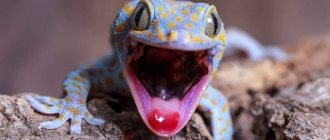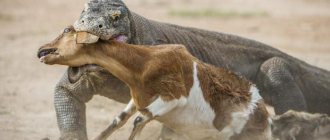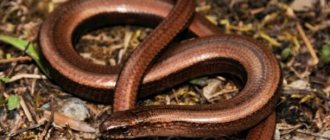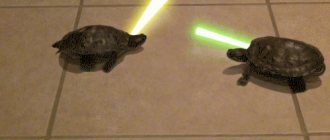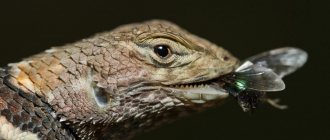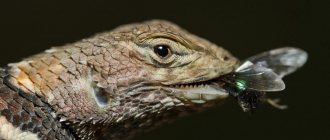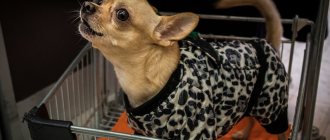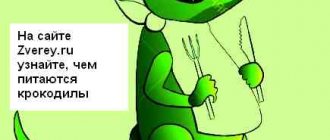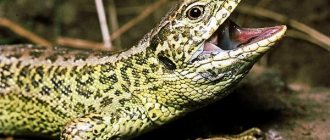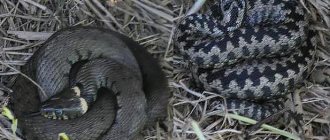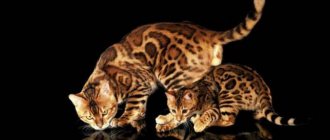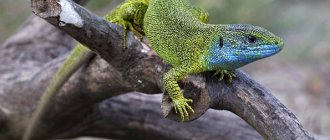The black-and-yellow giant lizard (lat. Tiliqua nigrolutea) belongs to the skink family, Rodutiliqua. This is a very impressive creature, which, moreover, has a peaceful character and tolerates existence well in captivity. That is why representatives of the species often become inhabitants of terrariums among exotic lovers.
In the wild, the black-and-yellow giant lizard lives in the south-eastern part of Australia, northern Tasmania and some islands of the Bass Strait. It can be found in almost any area: from mountains to plains with sparse vegetation.
Leads a daily lifestyle. At night, it prefers to hide in shelters, like other representatives of the genus. It feeds mainly on leaves, fruits and flowers. She will not refuse small invertebrates, but most of all she likes snails and slugs. It may also attack small rodents or feast on carrion.
This is a rather large lizard that grows up to 35-50 cm in length. It has a flattened body, a large head and small limbs. The upper part of the body is dark. Its color varies from black to chocolate brown. Small spots of cream, orange or yellow color are scattered throughout the body, which merge into short transverse stripes.
Black and yellow giant lizards are viviparous. Their pregnancy lasts about four months and ends with the birth of 8 cubs.
In the wild, they have to face many dangers: dingoes, birds of prey, snakes, wild cats and dogs love to snack on gigantic lizards. In captivity, the life expectancy of tiliquas reaches 10-15 years.
A lizard is an animal that belongs to the class of reptiles (reptiles). To date, almost 6,000 species are known. Representatives of families can differ greatly; some rare varieties are listed in the Red Book. Lizards are both reptiles with legs and some legless forms. Reptiles can be vegetarians and eat animal foods. Some varieties are suitable for keeping at home.
Unlike snakes, these reptiles have divided eyelids. Their body is elastic, elongated, ending in a long tail. Paws are proportional, clawed.
According to the general characteristics, the body is covered with keratinized scales, which change several times a year. The tongue can have different shapes; it is usually mobile and extends out of the mouth. It is with them that lizards catch prey. On both sides of the head are the hearing organs, which are covered by the eardrums.
The most common reptile is the true lizard. Her body length is 40 cm.
Teeth are used for tearing and grinding food. Monitor lizards use them to cut up their prey.
The only poisonous species of lizard is the poison tooth.
Reptiles live on all continents except Antarctica. Representatives familiar to Russia—real lizards—live almost everywhere. All species move on different surfaces, clinging tightly to uneven surfaces. Rock lizards are excellent jumpers, their jump height reaches 4 m.
Lizards are capable of autotomy, which is used in case of danger: muscle contraction allows you to break the cartilaginous formations of the vertebrae and discard part of the tail, narrowing the blood vessels, with almost no blood loss. This distracts the enemy, and the animal avoids the attack.
Description [edit | edit code ]
Appearance [edit | edit code]
A large lizard 35-50 cm long. The color of the upper side of the body is dark: from chocolate brown to black with small spots of cream, pink or orange, which merge into transverse stripes. The head is colored lighter than the body. Individuals from the northern parts of the range, living in mountainous areas, are, as a rule, larger and darker in color, their light spots are brighter than those of skinks from lowland habitats in the south of the range.
Distribution[edit | edit code ]
The black-and-yellow giant lizard is a narrowly distributed species. It is found in south-eastern Australia, northern Tasmania and some adjacent islands in Bass Strait.
Lifestyle[edit | edit code ]
In the north of its range, this skink lives mainly in mountainous areas. In the south (in Tasmania and Victoria), the black-and-yellow giant lizard can be found on the plains all the way to the coast. It lives in rocky semi-deserts, among sparse shrub vegetation. Doesn't avoid
Food [edit | edit code ]
It feeds mainly on plant foods: leaves, flowers and fruits. Can hunt invertebrates (for example, snails and slugs) and small vertebrates (rodents).
Reproduction [edit | edit code ]
Like all species of the genus Tiliqua
, black and yellow gigantic lizard - viviparous. In Tasmania, this skink appears after wintering at the end of September. Mating occurs in October. In March-April, females give birth to up to 8 cubs.
Structural features of lizards
As many species of lizards exist on earth, so do their external characteristics. Unlike their descendants, snakes, lizards have limbs. Most lizard species have vocal cords that enable them to produce loud sounds.
Lizards' teeth are designed to capture or tear food. The tongue comes in different shapes and lengths, depending on the type of lizard. The brain is better developed in comparison with amphibians and fish, although it is small in size.
Lizards' ears perform not only the function of hearing, but also help maintain balance. Many species can discard their tail in case of danger; the discarded tail grows back, but has a darker color.
Links
- [www.amonline.net.au/factsheets/blue_tongue_lizard.htm Blue-tongued Lizards in New South Wales]
- [eprints.utas.edu.au/662/1/mating_behav_paper.pdf Edwards A. & Jones S. M. Mating behavior in the blotched blue-tongued lizard, Tiliqua nigrolutea
, in captivity.] - [web.archive.org/web/20080721012819/www.rzsnsw.org.au/publications/AZ30-3/AZ30-3_Hancock_and_Thompson_340-345.pdf Hancock LJ & Thompson MB Distributional limits of Eastern Blue-tongue Lizards Tiliqua scincoides
, Blotched Blue -tongue Lizards
T. nigrolutea
and Shingleback Lizards
T. rugosa
(Gray) in New south Wales.]
Is it possible to breed independently?
Home breeding of leopard geckos of the Black Night morph is hardly possible. Even the developers of this morph themselves, the process of obtaining the black color of the lizard took more than 15 years. However, the dark color of the lizard is still genetically unstable; the next offspring may produce lighter individuals.
In our country, a number of breeders are working on creating coal-black specimens. At the moment, we have only managed to achieve a darker color compared to previous generations of the same line. It is known that the most resinous color of the Black Night morph is obtained by crossing dark individuals with lizards of the Patterless line. It is safe to say that charcoal color has a cumulative effect. However, no one has yet succeeded in fixing the black color in subsequent offspring.
⬇⬇⬇ Below is a video that talks about the process of breeding the black morph Black Night and all the difficulties in doing so. We recommend watching with Russian subtitles.
The character and behavior of leopard geckos in natural conditions
The leopard gecko carries out its main life activity in the dark, and during the day the reptile hides from bright light in burrows, crevices between pebbles, and under the roots of plants. In nature, the reptile feeds on larvae, caterpillars, insects, small mammals and arthropods.
The male gecko acquires a small harem of females (5-6 individuals). As the true head of the family, he guards his personal territory and protects his ladies and offspring from danger.
At nine months of age, leopard geckos become sexually mature and capable of reproduction. The female lays 1-2 eggs ten times a year. After 2-3 months, baby geckos are born.
When an animal senses danger or experiences pain, the tail is discarded and then a new one grows in its place - quickly in young individuals, much more slowly in adults.
Leopard geckos carry out most of their life activities at night
The process of keeping and breeding various leopard geckos, including the Black Night morph, is fascinating and interesting. It is important to remember that you should be responsible for any living creature placed in an aquaterrarium.
Did you like the Black Night morph? Share in the comments!
Brittle spindle
The spindle family includes a huge number of species. There are more than a hundred of them in total. The general characteristics of spindles have already been presented in this article. Now we will talk about one of the most prominent representatives of the family - the brittle spindle. By the way, the legless snake-like lizard and the spindle are not the same thing. There is a big difference between them: for example, spindles have auditory openings and temporal arches.
The length of these reptiles reaches 45 centimeters. Two thirds of their body is a flexible, movable tail. At the same time, the border between the body and the tail is almost invisible to the naked eye. The scales of the animal are reinforced with bone plates. Typically, spindles have gray or brown scales with a copper sheen. However, there are also albino individuals, as well as melanists, whose color is completely black. The cubs were once mistakenly classified as a separate species, because at an early age their coloration divides the body into two halves: chocolate and golden. You can meet brittle spindle in the forests. Sometimes she crawls into fields and gardens. In addition, this reptile can swim, so occasionally it appears near bodies of water.
LiveInternetLiveInternet
—Categories
- knitting (507)
- jackets (38)
- hats, scarves (38)
- dresses (33)
- tops, tunics (31)
- sweaters, pullovers (20)
- mittens (17)
- knitting master classes (16)
- knitted shoes (16)
- vests (11)
- knitting magazines (9)
- scarves (7)
- swimwear (6)
- socks (6)
- bags (5)
- skirts (5)
- ribbon lace (2)
- kits (2)
- coat (1)
- Bruges lace (1)
- bandages (1)
- cooking (463)
- conservation (93)
- pies, pizzas (50)
- fish dishes (34)
- salads (26)
- chicken (23)
- sauces, mayonnaise (22)
- desserts (20)
- main courses (18)
- pancakes, pancakes (13)
- made from meat (12)
- jam (12)
- zucchini dishes (10)
- sushi (9)
- lard (8)
- snacks (6)
- cakes (5)
- jelly (4)
- cookies (3)
- soups (3)
- pates (2)
- dumplings, dumplings, chebureki (2)
- bread (2)
- spices (2)
- offal (1)
- Porridge (1)
- eggplant dishes (1)
- cheese (1)
- cutlets (1)
- flowers (162)
- for home (132)
- knitting my wishes (105)
- sewing (92)
- MK sewing (29)
- curtains (10)
- bags (5)
- for home (3)
- knitting for children (91)
- hats (24)
- sweaters (22)
- socks, booties (13)
- toys (10)
- shoes (8)
- scarves (8)
- Mittens, gloves (1)
- Jumpsuits (1)
- Envelopes (1)
- dresses (1)
- knitting lessons (83)
- DIY cosmetics (73)
- for skin (10)
- for hair (6)
- for nails (1)
- garden - vegetable garden (58)
- beauty secrets (54)
- health (46)
- nail health (4)
- for face (3)
- drawing (32)
- newspaper weaving (30)
- knitting for men (25)
- Irish lace (23)
- feng shui (23)
- beauty recipes from Olga Seymour (22)
- knitting for home (20)
- interesting for us! (17)
- essential oils (17)
- psychology (16)
- beads (16)
- for business (16)
- COMPUTER (14)
- programs (3)
- miscellaneous (14)
- figure (13)
- raising a child (12)
- esoterics (10)
- nail extensions (10)
- DIY candles (10)
- drinks (9)
- New Year (8)
- Tourism and travel (8)
- for the kitchen (8)
- master classes (8)
- knitted shorts (8)
- makeup (7)
- knitting for the bathroom (6)
- aromatherapy (6)
- from narrow ribbons (6)
- knitted toys (5)
- recipes for Easter (5)
- Dukan diet (5)
- wine (4)
- for diary (4)
- medicinal herbs (3)
- aquarium (3)
- handicrafts (2)
- cross stitch (2)
- crochet (2)
- fashion (2)
- repurposed old things (2)
- interesting for children (2)
- hairstyles (2)
- Detailed practical yoga (2)
- Raw food diet (1)
- handmade carpets (1)
- catch phrases (1)
- pets (1)
- mineral stones (1)
- from Faina Ranevskaya (1)
- macrame (1)
- congratulations, cards (1)
- sacred (1)
- books and magazines on cutting and sewing (1)
- about photography (1)
- dried fruits (0)
- headbands (0)
—Links
—Search by diary
—Subscription by e-mail
-Statistics
Longest title
The longest title among the nobles who owned lands in Crimea was apparently held by Prince Grigory Alexandrovich Potemkin-Tavrichesky. His full title is as follows: His Serene Highness Prince Potemkin-Tauride, President of the State Military Collegium, Field Marshal General, Great Hetman of the Cossack, Ekaterinoslav and Black Sea troops, Commander-in-Chief of the Ekaterinoslav Army, regular light cavalry, Black Sea Fleet and other land and sea military forces; Senator, Ekaterinoslav, Tauride and Kharkov Governor-General; Her Imperial Majesty's troops Inspector General, Adjutant General, Acting Chamberlain, Life Guards Preobrazhensky Regiment Lieutenant Colonel, Corps of Cavalry Chief; Orders of Andrei Nevsky, St. George, Equal to the Apostles Prince Vladimir, St. Anne, Prussian Black Eagle, Danish Elephant, Swedish Seraphim, Polish White Eagle, St. Stanislaus Knight.
Types of domestic lizards
Chameleon
A lizard capable of changing color depending on its environment. In the wild, the ability is used as camouflage. The length can exceed 50 centimeters.
The smallest representatives are only 3-5 centimeters long. For home conditions, the most common are Yemen chameleons.
Gecko
Small and very peculiar lizards. Inhabitants of tropical and subtropical climates. The structural features of the gecko's paws help it move along any vertical surfaces and even along the ceiling. They are active mainly at night. They can make sounds.
Agama lizard
Medium sized lizard. The length, depending on the type, can range from 8 centimeters to one meter. Found in Europe, Asia, Africa and Australia.
Iguana
The lizard, which lives in Central and South America, prefers a diurnal lifestyle. It can exceed two meters in length and weigh eight kilograms.
It has bright and attractive colors, a calm disposition and a friendly character, which is why it is popular for home keeping, but requires careful care.
